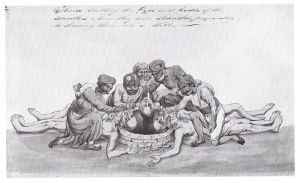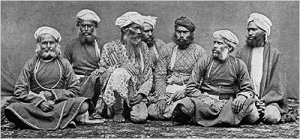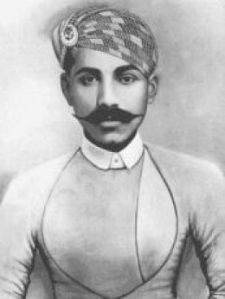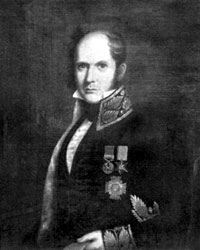
A group of Thugs stabbing the eyes of recently murdered travelers, prior to throwing them into the well. Artist unknown, 1830’s.
The place is India, in the era of the British Raj.
Imagine traveling on a dark road. You and some traveling companions are making your way to a distant city. Perhaps you’re a merchant with wares to sale. The roads are dangerous, especially at night, and there’s safety in numbers. Your party allows yet another fellow traveler into your caravan, someone unknown to you. It’s not an uncommon occurrence in your day. After a few days on the road together, after your confidence is gained, it strikes. You never see it coming. Strangled. Mutilated. Dumped in a well or a shallow grave. Nothing is ever seen or heard of you again.
The event described above was a creation of mine. An event that never happened, yet happened 1,000 times…and 1,000 times again. The perpetrator of the crime was a member of the Thuggee cult, which incidentally gave the English language the word thug. They were feared by all and the extent of their crimes may never be known. Thug Behram, a leader of the cult during the early 1800’s, claimed to have murdered 125 men with his own hands, while attending to a total of 931 murders! If the latter total were correct, it could be claimed that Behram were the most prolific serial killer in history.
The Cult of Kali
When the Thuggee cult came into existence is a matter for debate. Some evidence points to the group having been around since the 14th century, maybe even before. They committed their crimes across Central India. They were made up of both Muslim and Hindu adherents. Low estimates for their death toll stand around 50,000, while higher estimates put it at over 1,000,000.
Membership into the cult was supposedly generational, passed down from father to son. They were devotees of Kali, the Hindu goddess of death and destruction. Their killings were made in her honor and to appease her. Kali in a foul mood could mean the end of humankind.
While some of the details of the cult’s existence and motivation may be up for debate, their methods are not. They would gain acceptance into groups of travelers or caravans making their way across India. They preyed on long haul travelers. The act was usually carried out at night, while the camp slept. There may have been multiple Thugs who had joined the procession or there may be Thugs tailing the group, lying in wait somewhere. When the time was right, they would strangle their victims, often using their cummerbund or sash. They would dispose of the body by dumping it in a well or burying it. The remains would likely never be found.
Careful choice of both victim and crime scene were key to Thuggee success. They would wait until the perfect moment. Distance from a victim’s home, distance from the nearest town, the victims’ level of suspicion, and much more would be factored in. If all the elements for a flawless getaway did not add up, the killers would wait or perhaps let the target go.
Silence and cohesion were also key. Striking as a unit while the victims were at their most vulnerable left little hope for their prey. Few ventured out at night, and these remote campsites gave them all the time they needed to dispose of any evidence, while leaving little chance for escape should something go awry.
Thug Berham
As for the aforementioned Berham, little is known about his life. He was born in the 1760’s and died in 1840, hanged by the authorities. It’s hard to say whether his claims have any merit. He undoubtedly participated in numerous killings. The scale of the Thuggee enterprise was overwhelming.
Berham’s descendents later claimed that crooked East India Company officials ended up with much of his loot. The 125 murders that he did confess to were accompanied by treasure hunts. Once he realized he would never be free, nor be shown clemency, he ceased admitting to murders. Who knows how high the number might have risen.
Suppression
Beginning in the 1830’s, attempts to suppress one of the biggest menaces to British rule in India were underway. Using improved crime fighting techniques and better communication between the various locals, William Sleeman and other administrators were finally able to put the clamp on the murderous cult. By 1870, the Thuggee Cult was finally broken up by the British authorities. Hundreds were executed and thousands more were arrested or expelled. A centuries-long wave of terror was over.
One of the side effects of the eradication of the cult was the Criminal Tribes Act of 1871. Tribes who were ‘habitually criminal’ would be registered by officials and generally harassed by the powers that be. The stigma of criminal castes and tribes still lingers today.
Much was written about the cult during the suppression (and shortly after). Books such as Phillip Meadows Taylor’s Confessions of a Thug provided fascination and nightmares to Victorian England.
My How Times Change
Highway banditry is no longer as prevalent as it once was. For most of us, the idea is unthinkable. Yet there was a time when traveling, even to the next town, was fraught with danger. Spending the night outside, away from the safety of a settled encampment, entailed serious risk. India was not alone in this regard.
There are few cases as documented as this. Murder-robbery along trade routes would have slowly eroded in most places, as civilization encroached on the forests and wilderness used for such ambushes. The arrival of the British and the administration they imposed fast-tracked the process. As such, it’s all fully recorded and archived.
Think about it next time you take an hour car ride through the country. Times weren’t always this easy.
More Reading
- How British Raj Ended Thuggee in India (2ndlook.wordpress.com)
- The Sinister Canova Medallion (Zimbio)




Fascinating reading. It makes the Comancheros pale into insignificance!
It definitely does. Criminal enterprises in today’s world, in a first world country would be attacked and broken up so swiftly if they came even close to matching the Thuggee level of violence. People got away with murder back then…. nowadays, not so much.
I’m sure that, like me, most people had their first introduction to the Thuggees via “Indiana Jones and the Temple of Doom.” They are a fascinating phenomenon, with similar groups thriving in other parts of the world around the same time, especially in Mexico and China. I can’t help but wonder, by the way, if India’s contemporary string of horrible road-side gang-rapes has echoes of the Thuggees’ legacy.
You’re showing your age, Jarret! There’s really no way to accurately identify a correlation. If there is, it brings things back to the days of the ‘criminal classes’ which I’m sure many people would like to forget.
About your claimed photo of Behram Thugee – awful. It is NOT Behram. It is a portrait of the great Dhrupad singer Ziauddin Khan Dagar. Dhrupad is an ancient genre of Indian classical music, solemn, somber and deeply devotional.
Behram Khan was one of his forebears, himself a most renowned Dhrupad musician.
Neither was related in any way whatsoever to Behram Thugee.
Please remove this photograph.